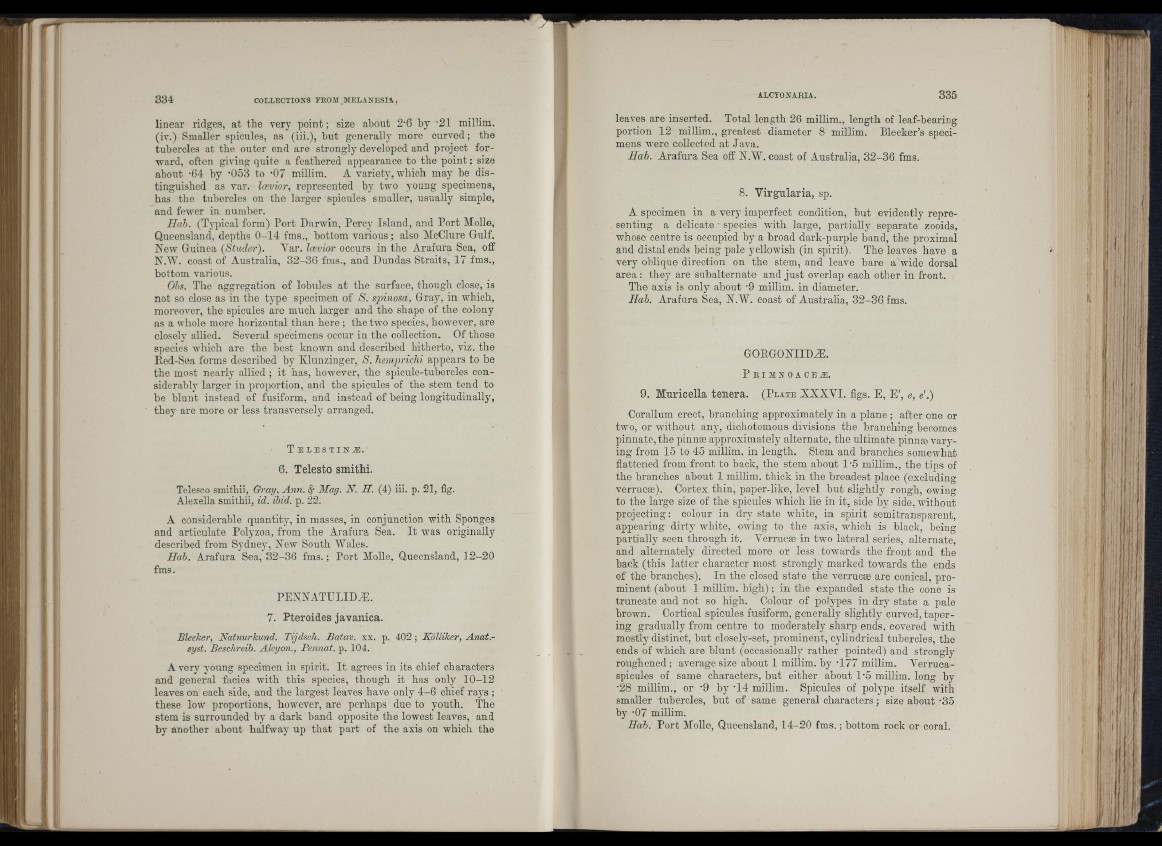
î" I
jî
linear ridges, at the very point; size about 2-6 by -21 millim.
(iv.) Smaller spicules, as (iii.), but generally more curved ; the
tubercles at the outer end are strongly developed and project forward,
often giving quite a feathered appearance to the point ; size
about -64 by ‘053 to -07 millim. A variety, whieh may be distinguished
as var. lævior, represented by two young specimens,
has the tubercles on the larger spicules smaller, usually simple,
and fewer in number.
Hah. (Tj-pical form) Port Darwin, Percy Island, and Port Molle,
Queensland, depths 0 -14 fms., bottom various; also McClure Gulf,
New Guinea (Studer). Var. lævior occurs in the Arafura Sea, off
N.AV. coast of Australia, 32-36 fms., and Dundas Straits, 17 fms.,
bottom various.
Ohs. The aggregation of lobules at the surface, though close, is
not so close as in tho type specimen of S. spinosa. Gray, in which,
moreover, the spicules are much larger and the shape of the colony
as a whole more horizontal than here ; the two species, however, are
closely allied. Several specimens occur in the collection. Of those
species which are the best known and described hitherto, viz. the
Bed-Sea forms described by Klunzinger, S. hemprichi appears to be
the most nearly allied ; it has, however, the spicule-tubercles considerably
larger iu proportion, and the spicules of the stem tend to
be blunt instead of fusiform, and instead of being longitudinally,
they are more or less transversely arranged.
T e l e s t i n æ .
6. Telesto smithi.
Telesco smitlni. Gray, Ann. Mag. N. II. (4) iii. p. 21, fig.
Alexella smithii, id. ibid. p. 22.
A considerable quantity, in masses, in conjunction with Sponges
and articulate Polyzoa, from the Arafura Sea. I t was originally
described from Sydney, New South AVales.
Hah. Arafura Sea, 32-36 fms.; Port MoUe, Queensland, 12-20
fms.
PENNATULIDÆ.
7. Pteroides javanica.
Bleeker, Natuurkund. Tijdsch. Batav. xx. p. 402 ; Kolliker, Anat.-
syst. Beschreib. Alcyon., Pennat. p. 104.
A very young specimen in spirit. I t agrees in its chief characters
and general facies with this species, though it has only 10-12
leaves on each side, and the largest leaves have only 4 -6 chief raj"s ;
these low proportions, however, are perhaps due to youth. The
stem is surrounded by a dark band opposite the lowest leaves, and
by another about halfway up that part of the axis on which the
leaves are inserted. Total length 26 millim., length of leaf-hearing
portion 12 millim., greatest diameter 8 millim. Bleeker’s specimens
were collected at Java.
Hab. Arafui’a Sea off N.AV. coast of Australia, 32-36 fms.
8. Virgularia, sp.
A specimen in a very imperfect condition, but evidently representing
a delicate ■ species with large, partially separate zooids,
whoso centre is occupied by a broad dark-purple hand, the proximal
and distal ends being pale yellowish (in spirit). The leaves have a
very oblique direction on the stem, and leave hare a wide dorsal
a r e a ; they are subalternate and ju st overlap each other in front.
The axis is only about '9 millim. in diameter.
Hah. Arafura Sea, N.AV. coast of Australia, 32-36 fms.
g o b g o n i id h :.
P r i m n o a c e .®.
9. Muricella tenera. ( P l a t e XXXVI. figs. E, E', e, e'.)
Corallum erect, branching approximately in a plane ; after one or
two, or without any, dichotomous divisions the branching becomes
pinnate, the pinnae approximately alternate, the ultimate pinna? varying
from 15 to 45 millim. in length. Stem and branches somewhat
fiattened from front to back, the stem about 1-5 millim., the tips of
the branches about 1 millim. thick in the broadest place (excluding
verrucae). Cortex thin, paper-like, level but slightly rough, owiug
to the large size of the spicules which lie in it, side by side, ivithout
projecting: colour in dry state white, in sjiirit semitransparent,
appearing dirty white, owing to the axis, which is black, being
partially seen through it. A*erruca9 in two lateral series, alternate,
and alternately directed more or less towards the front and the
hack (this latter character most strongly marked towards the ends
of the branches). In the closed state the verrucee are conical, prominent
(about 1 millim. high); in the expanded state the cone is
truncate and not so high. Colour of polypes in dry state a pale
brown. Cortical spicules fusiform, generally slightly curved, tapering
gradually from centre to moderately sharp ends, covered with
mostly distinct, hut closely-set, prominent, cylindrical tubercles, the
ends of which are blunt (occasionally rather pointed) and strongly
roughened ; average size about 1 millim. by ‘177 millim. Verruca-
spicules of same characters, but either about 1'5 millim. long by
•28 millim., or '9 by '14 millim. Spicules of polype itself with
smaller tubercles, but of same general characters; size about ’35
by ‘07 millim.
Hah. Port MoUo, Queensland, 14^20 fms.; bottom rock or coral.
i
If ¡
:■ I ' i
I'i 11
CM
: f: i
I ‘ ,'f
iii'
ii
;